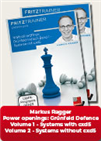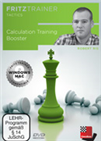Almost there
 Richard Rapport scored a momentous victory against Maxime Vachier-Lagrave in their first semifinal game at the Grand Prix in Belgrade. The Hungarian grandmaster now only needs a draw to reach the final, which would vastly increase his chances of getting a ticket to the upcoming Candidates Tournament. Rapport also made it to the semifinals at the first stage of the series, played last month in Berlin.
Richard Rapport scored a momentous victory against Maxime Vachier-Lagrave in their first semifinal game at the Grand Prix in Belgrade. The Hungarian grandmaster now only needs a draw to reach the final, which would vastly increase his chances of getting a ticket to the upcoming Candidates Tournament. Rapport also made it to the semifinals at the first stage of the series, played last month in Berlin.
 The search continues for a refutation of the Benko (a.k.a. Volga) Gambit, and White is quite happy if he can achieve a slight advantage. According to the Icelandic grandmaster Henrik Danielsen, to get this White should accept the gambit and go on to fianchetto his king's bishop. The key move is 10.Rb1 — meaning that at any point White is prepared to play b3. And the key game is Kramnik-Topalov from Wijk 2003 — since then the Bulgarian has never again played the Benko. With his video series the author provides a complete repertoire for White against this gambit which still remains very popular with club players.
The search continues for a refutation of the Benko (a.k.a. Volga) Gambit, and White is quite happy if he can achieve a slight advantage. According to the Icelandic grandmaster Henrik Danielsen, to get this White should accept the gambit and go on to fianchetto his king's bishop. The key move is 10.Rb1 — meaning that at any point White is prepared to play b3. And the key game is Kramnik-Topalov from Wijk 2003 — since then the Bulgarian has never again played the Benko. With his video series the author provides a complete repertoire for White against this gambit which still remains very popular with club players.Playing white, Rapport made full use of MVL’s haphazard handling of a Grünfeld Defence. The eventual winner of the game had the more active bishop pair and got to successfully push his connected passed pawns to collect the all-important win.
Anish Giri also showed the power of the bishop pair. Unlike Rapport, though, Giri’s coordinated minor pieces were dealing with a materially imbalanced position. The Dutchman gave up two exchanges against Dmitry Andreikin out of a wild, double-edged Sicilian.
After such exciting games, we can only expect to see sharp rematches on Thursday. At the very least, it is very likely that MVL will go all out to even the score against his ever-creative opponent.

In a tough spot — Maxime Vachier-Lagrave
Rapport 1 - 0 Vachier-Lagrave
Once Maxime Vachier-Lagrave’s position seemed indefensible in his first semifinal game against Richard Rapport, well-known Grünfeld expert Peter Svidler reflected, “Very much a Grünfeld disaster for MVL today”.
Rapport played a line suggested by his wife, one that he thought was harmless. In a post-game interview, he apologized to her for doubting her suggestion, as the variation prompted MVL to play over-optimistically. The Frenchman quickly found himself in an inferior position.
14.Bd2 was the novelty in the game, although clearly none of the players had prepared for this sideline to appear on the board. Rapport spent no less than 36 minutes on this move, while MVL needed a bit over 20 to respond by 14...Bd7.
The game continued with 15.Nxd4 exd4 16.Rc1, attacking the queen, Qa3 17.Qb3
Swapping queens favoured White, who had strong mobile central pawns and better prospects for his bishop pair. Retreating with the queen, however, would have been worse for Black.
Once the queens left the board, the ever-fighting MVL tried to create counterplay instead of going for simplifications.
 You are looking for an active answer to 1.d4? Then the Grünfeld Indian is an excellent choice! Not by chance this opening is one of the main weapons of some top grandmasters!
You are looking for an active answer to 1.d4? Then the Grünfeld Indian is an excellent choice! Not by chance this opening is one of the main weapons of some top grandmasters!
As pointed out by Rapport, transferring either rook to the c-file was called for here, going for a damage-control approach. MVL’s 18...Rae8, which was the principled approach according to Rapport, on the other hand, did more harm than good.
After 19.f3 f5 (doubling down on his aggressive response) 20.Rc7 Bb5 21.a4 Bd3, White got to show the strength of his position.
22.d6+ was the beginning of the end for Vachier-Lagrave, who continued fighting in a miserable position until throwing in the towel on move 37.

White wins
Giri ½ - ½ Andreikin
In what later turned out to be an incredibly sharp game, Anish Giri was the first one to deviate from theory, and he did so by playing a favourite of Alpha Zero.
The imbalanced position, unsurprisingly, soon became more and more chaotic, with White’s king castled long and its black counterpart stuck in the centre. Amid the complications, Giri went for a knight sacrifice when retreating was the way to go.
Dmitry Andreikin himself later mentioned that 20.Nh3 would have been “a very strong move” even if Giri’s 20.Nxf7 looks so natural at first sight. The problem for White is that after 20...Kxf7 21.bxa5 Black has 21...Bd5, centralizing his bishop and creating a number of threats against White’s weakened queenside.
Giri realized things had not gone as well as, perhaps, he had planned a few moves ago, and soon decided to give up an exchange for the powerful light-squared bishop — 22.Qf4+ Kg8 (22...Ke8 was stronger) 23.Rxd5
 In this video course, twenty-nine examples with multiple questions are presented in the interactive format, which is ideal for a range of playing strengths. Step by step you will be taken through the complex positions.
In this video course, twenty-nine examples with multiple questions are presented in the interactive format, which is ideal for a range of playing strengths. Step by step you will be taken through the complex positions.
Moreover, after 23...Bg5 White is forced to give up yet another exchange with 24.Rxg5
Both rooks are en prise in a highly original position. By this point, Giri realized he had fully lost his advantage, but he also knew that the bishop pair plus his two extra pawns should be enough to get a draw.
The queens left the board on move 28 and a draw was signed five moves later.

Anish Giri facing Dmitry Andreikin
Links


















 Richard Rapport scored a momentous victory against Maxime Vachier-Lagrave in their first semifinal game at the Grand Prix in Belgrade. The Hungarian grandmaster now only needs a draw to reach the final, which would vastly increase his chances of getting a ticket to the
Richard Rapport scored a momentous victory against Maxime Vachier-Lagrave in their first semifinal game at the Grand Prix in Belgrade. The Hungarian grandmaster now only needs a draw to reach the final, which would vastly increase his chances of getting a ticket to the 







